These images—plus all the thousands more sent back from Cassini—show us that Saturn is an amazing, diverse, spectacular, and alien world. We’ve learned more about it in the 10 years Cassini has been there than we did in the hundreds of years since the invention of the telescope. The mission is due to be completed in just a few years, but its legacy will live on for far, far longer.
I remember staying up late that night, hunched over my computer, listening to the NASA and JPL feed, waiting almost literally on the edge of my seat for the news that the Saturn Orbital Insertion was complete. I remember my daughter, then just 8 years old, asking me what was going on, and I showed her some pictures of the spacecraft and what Saturn looked like as it approached.
That was a decade ago. My daughter enters college this fall, and a billion kilometers away Cassini still orbits the giant ringed planet, still points its cameras where we tell it, and still returns devastatingly gorgeous pictures to astronomers back on Earth. To celebrate this milestone I picked my ten favorite images from Cassini, one for each year our robotic proxy has examined Saturn. They will surely show you why Cassini has had such a profound impact on the public, because each is so amazing and so beautiful it would make any terrestrial artist jealous.
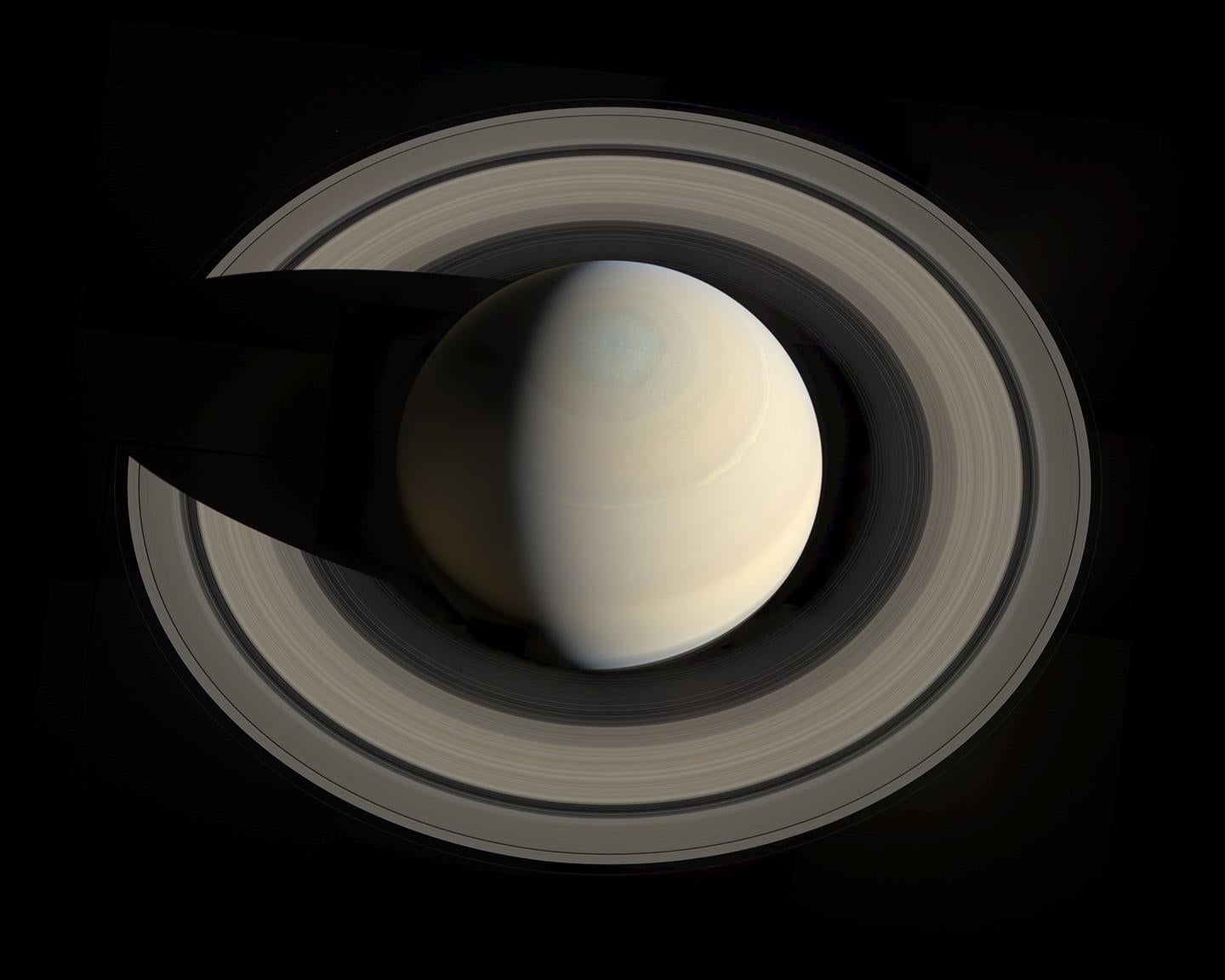
Photo by NASA/JPL/Space Science Institute/Gordan Ugarkovic
In October 2013, Cassini flew high above Saturn, looking down toward its north pole. It took a series of shots that were then assembled by software engineer Gordan Ugarkovic into what is, in my opinion, the single most breathtaking mosaic of Saturn ever taken. The detail in the full-resolution image is amazing. Moons, storms, rings … it’s all there. To me, this will always be an iconic picture of the ringed planet—and a triumph for Cassini.
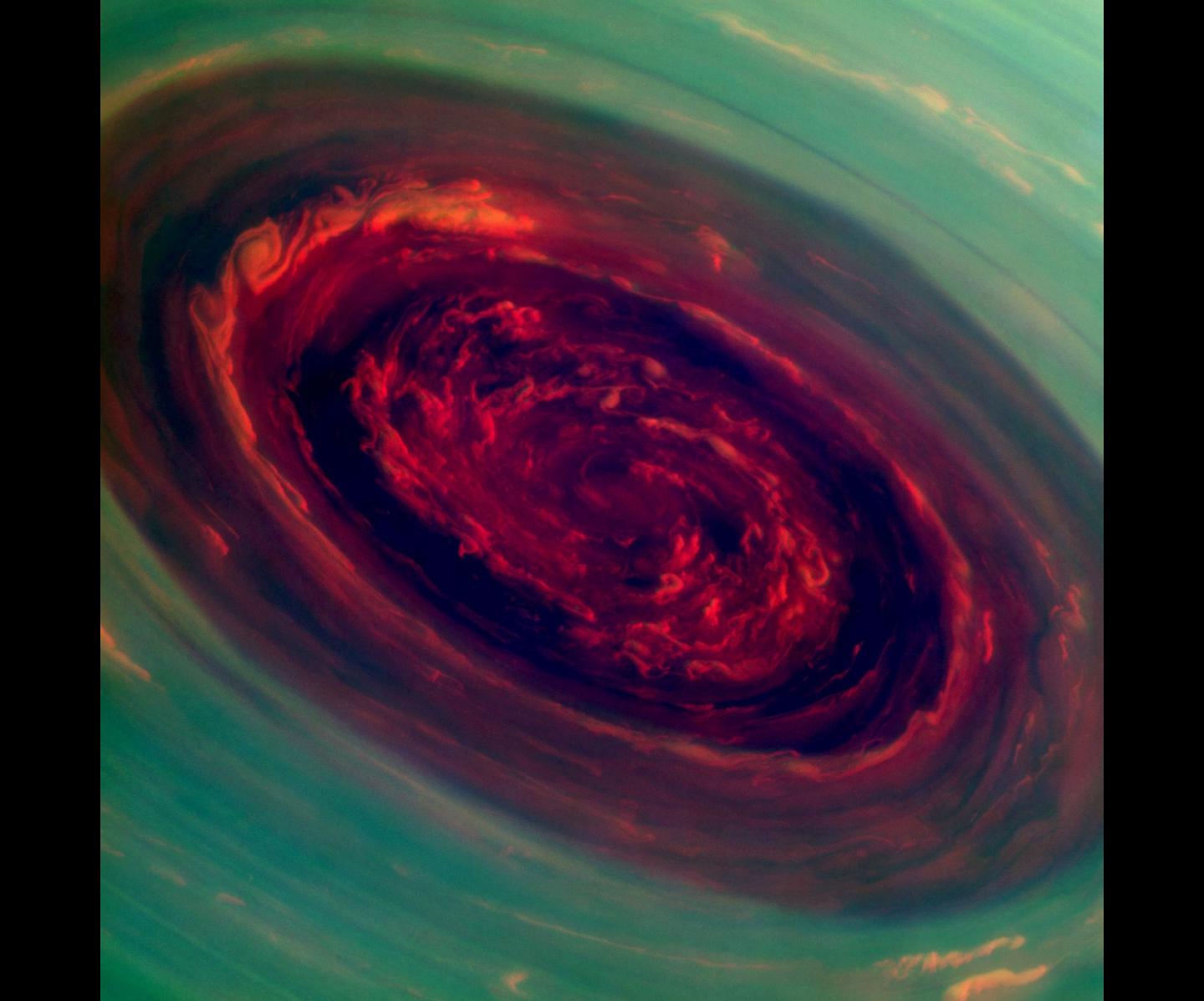
Photo by NASA/JPL/Space Science Institute
Centered on Saturn’s north pole is a huge hurricane, a raging cyclone more than 2,000 kilometers (1,200 miles) across. This infrared image shows low clouds as red and higher clouds as green, with smaller swirls and eddies festooning the interior. Wind speeds inside this eerie red eye have been measured at 500 kilometers per hour (330 mph), faster than a tornado.
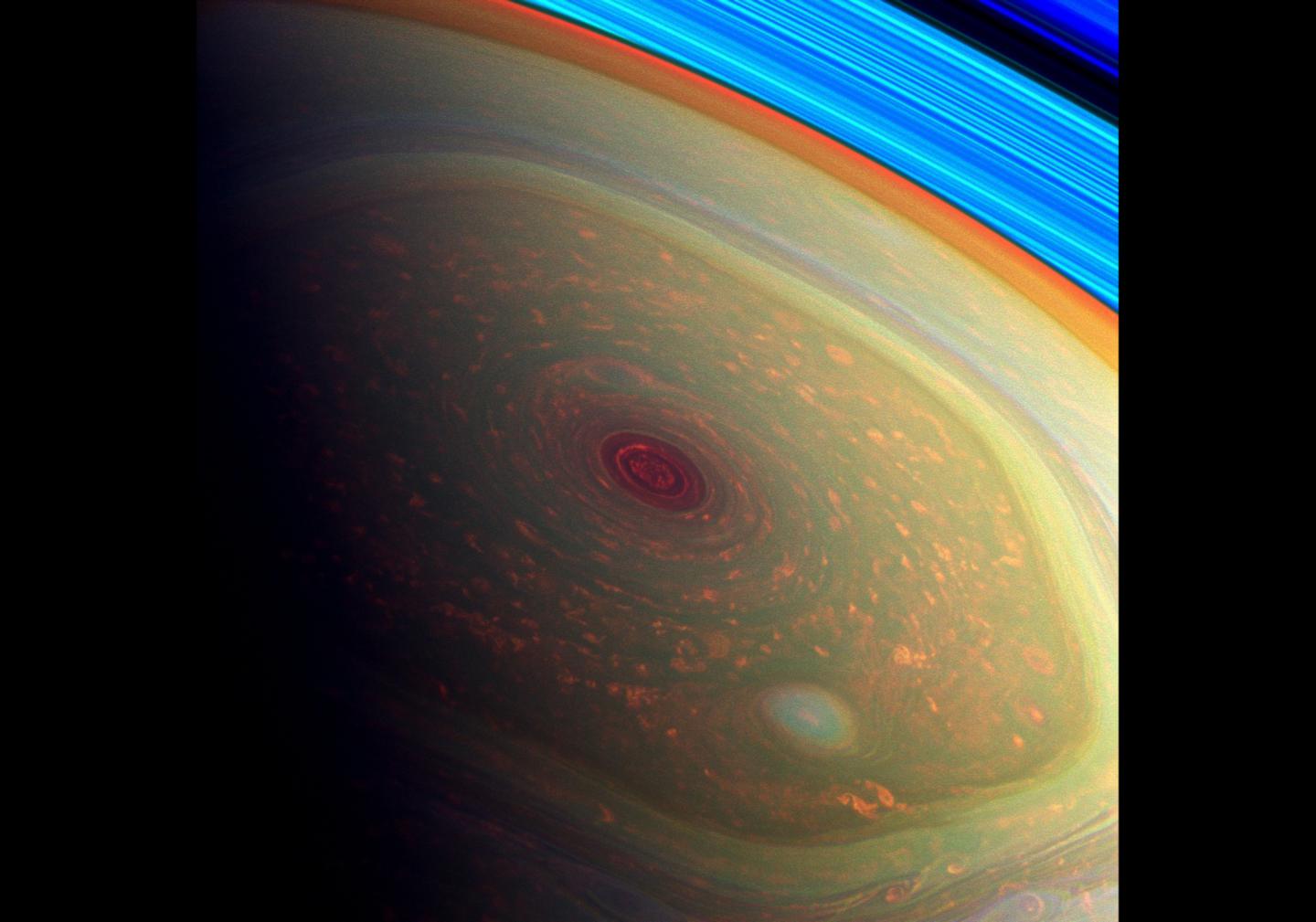
Photo by NASA/JPL/Space Science Institute
The hurricane shown above is actually at the center of a much bigger system called the North Polar Vortex. Similar to the Earth’s jet stream (but vastly larger), this rotating pattern of air takes on a hexagonal shape, which arises naturally in rotating fluids. The entire system is more than 20,000 kilometers (12,000 miles) across, much larger than the Earth itself.
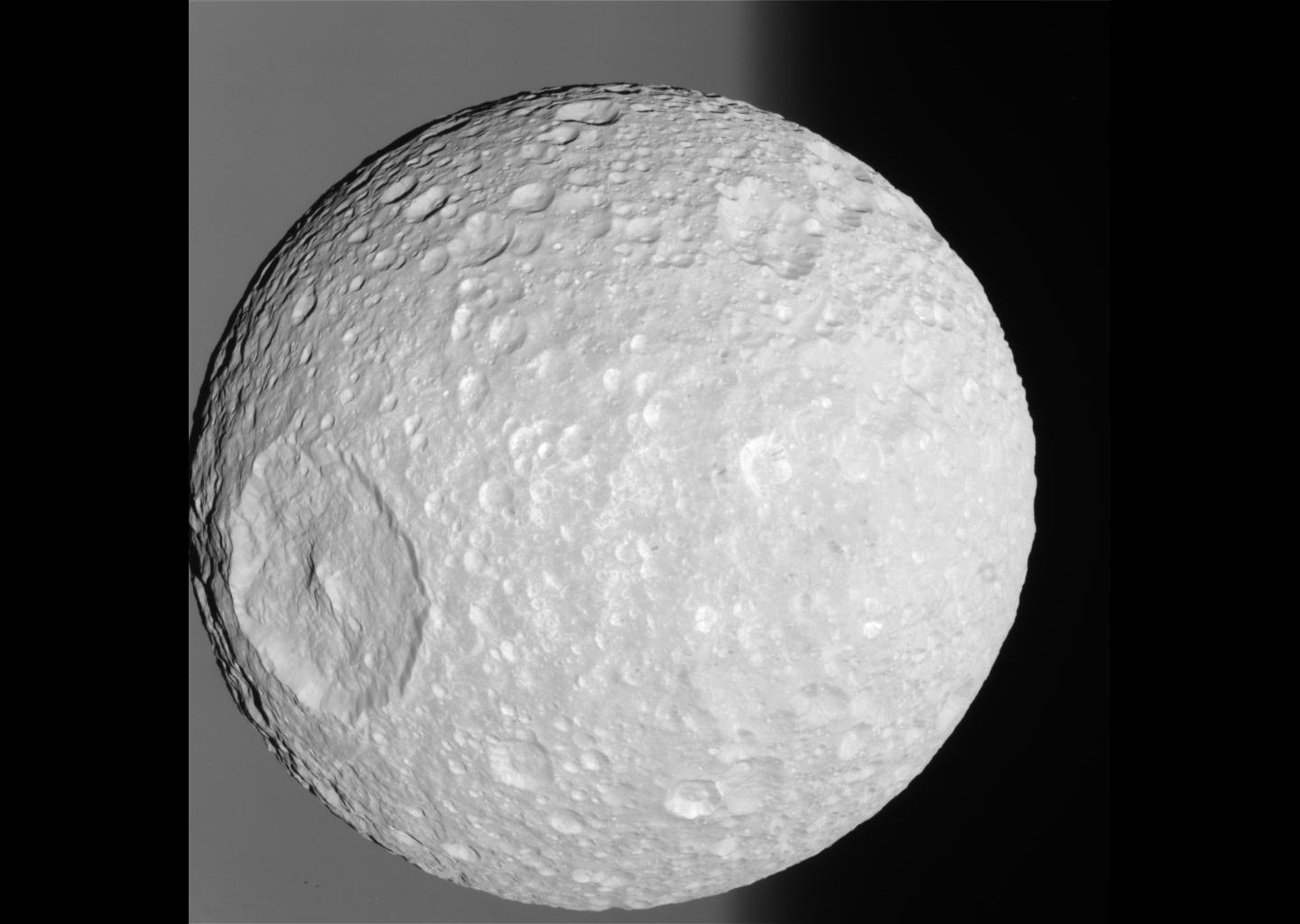
Photo by NASA/JPL/Space Science Institute
Saturn’s moon Mimas is about 400 kilometers (250 miles) across, and is mostly ice with some rock mixed in. Battered and cratered, it’s been impacted countless times. One very large impact created the Herschel crater seen here on the left. Scientists can glean a lot of information from such a crater … but no matter what we learn from it, in the end—and for obvious reasons—Mimas will always be known as the Death Star moon.
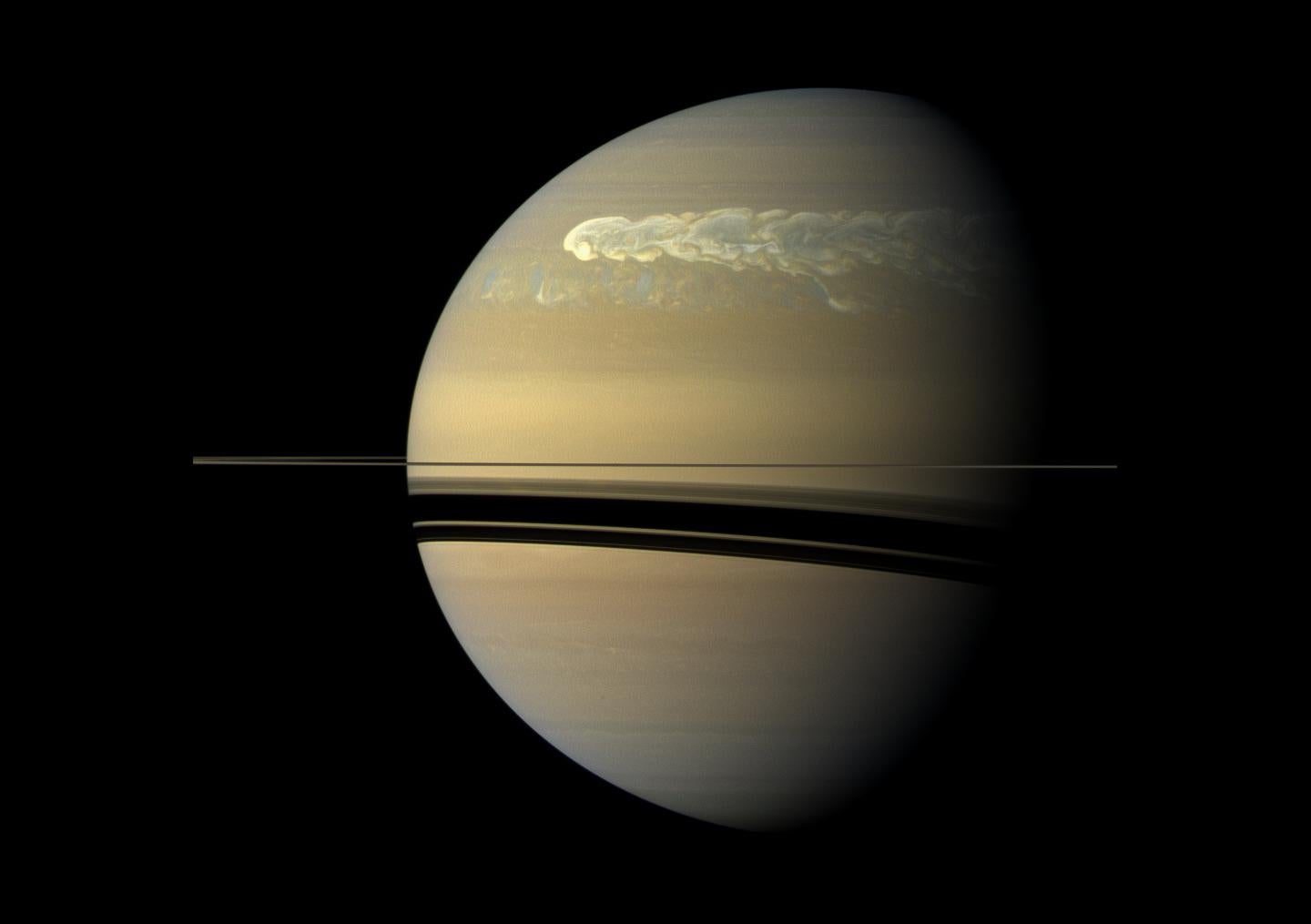
Photo by NASA/JPL/Space Science Institute
Summer storms are common on Saturn, but this one, which bubbled up from deep within the planet’s atmosphere in 2010, was extraordinary—it grew so long that it literally wrapped all the way around the planet, lapping itself. It raged for months before finally dissipating and grew to an astonishing 300,000 kilometers (180,000 miles) in length … long enough to stretch from Earth to three-quarters of the way to the Moon.
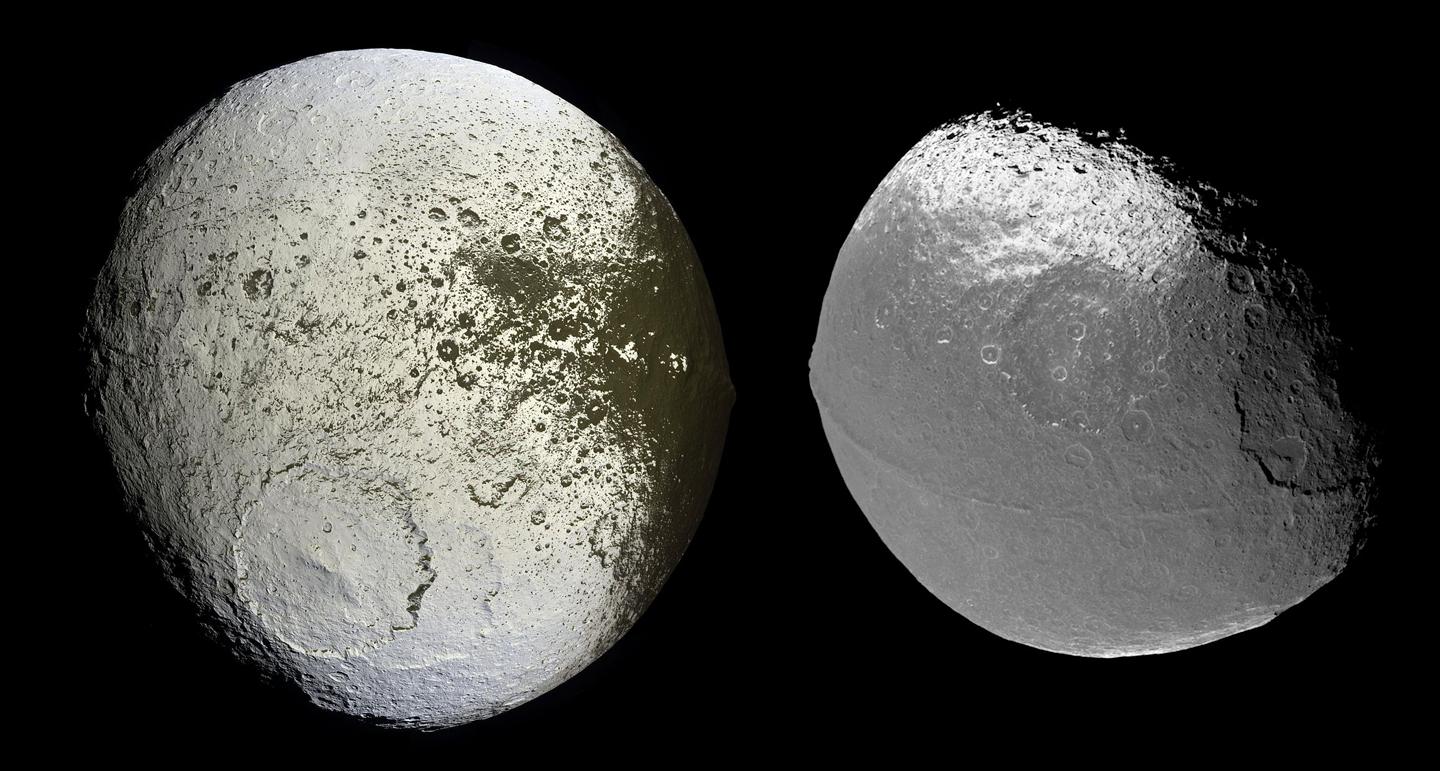
Photo by NASA/JPL/Space Science Institute
It’s hard to say any moon of Saturn’s is the weirdest (though see Hyperion, below), but Iapetus is a strong contender. One hemisphere (left) is icy and incredibly shiny, while the other is covered in darker organic material, probably deposited from dust blown off of other moons during impacts. Iapetus also has a huge ridge running along its equator (right), the origin of which is still somewhat mysterious but probably traces back to when the moon originally formed.
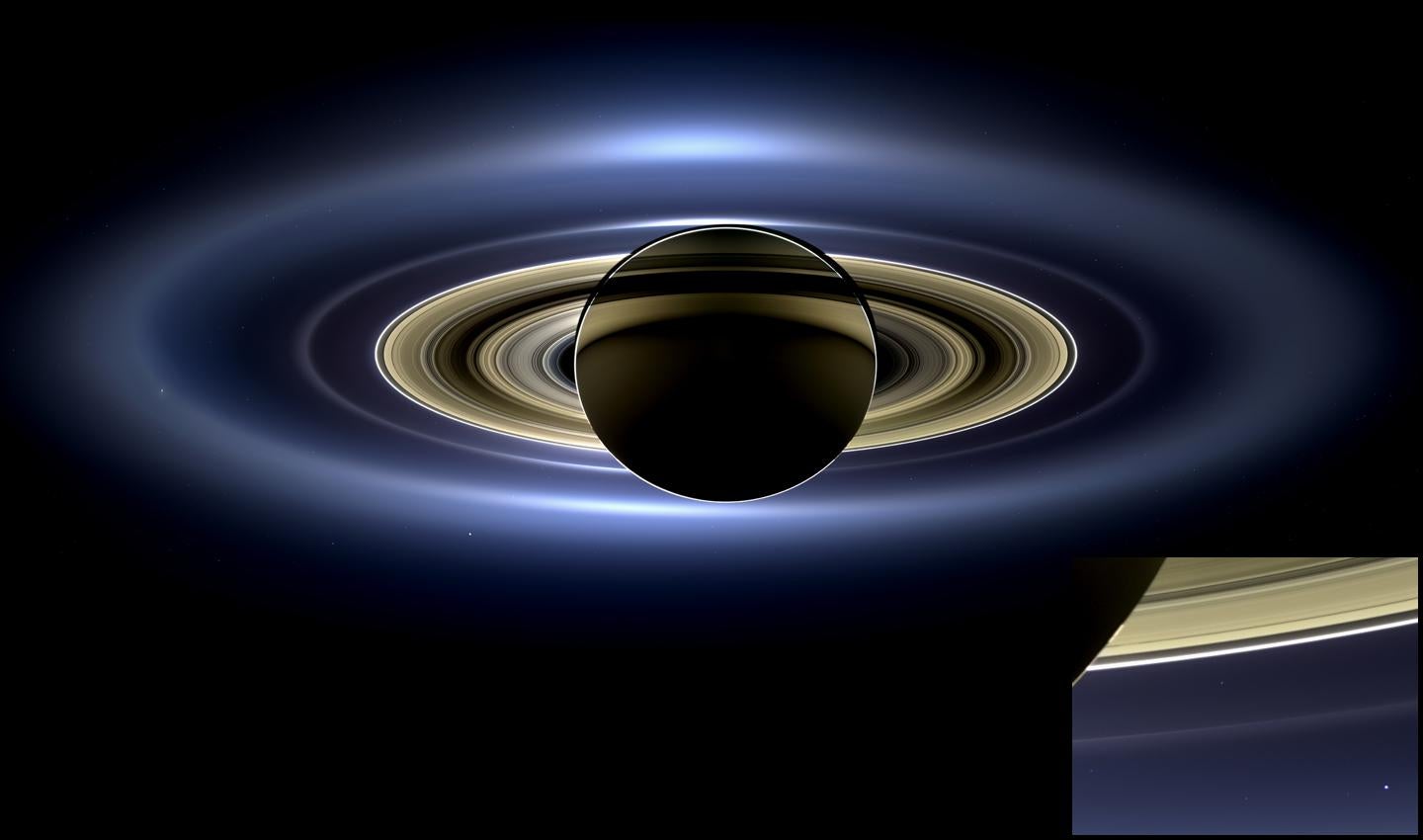
Photo by NASA/JPL/Space Science Institute
In July 2013, Cassini slipped “behind” Saturn as seen from the Sun. From its viewpoint, Cassini saw Saturn eclipsing the Sun, backlit, looking down on the midnight line of the world. From a distance of 1.2 million kilometers (750,000 miles), it took a series of pictures to create this magnificent mosaic. There is a vast amount to see in the full-resolution image (click the link for details), but of all of them, the best is just to the right and below the disk of the planet (inset): our home world, Earth, as seen from 1.4 billion kilometers (900,000 miles) away. In the full-resolution image you can even see the faint Moon next to it! On the day this image was taken, Carolyn Porco, imaging team leader of Cassini, organized a worldwide campaign to get everyone to look to Saturn, smile, and wave. More than 1,400 people sent in pictures of themselves waving, which were used to make a mosaic of a somewhat more familiar planet.
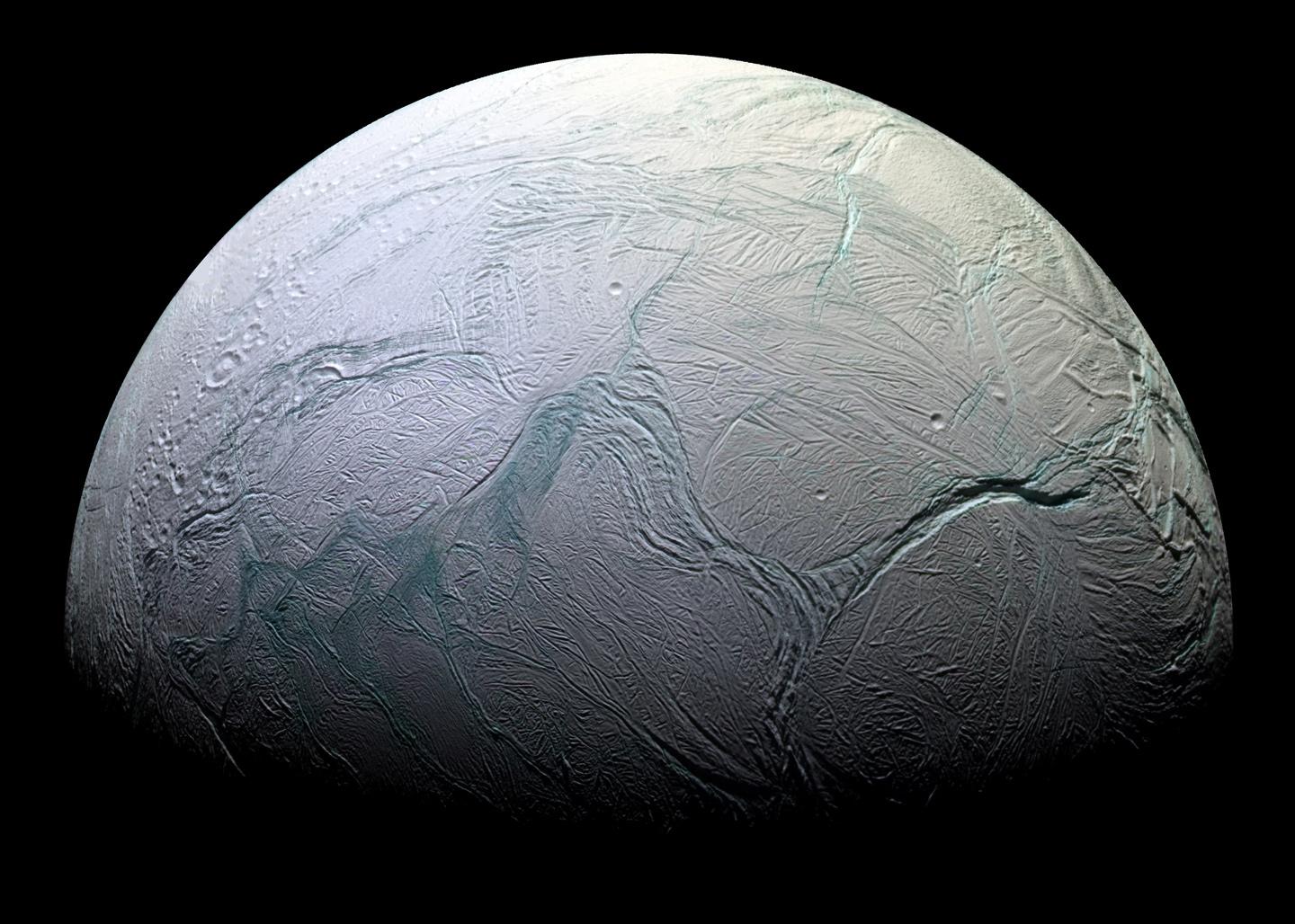
Photo by NASA/JPL/Space Science Institute
We tend to think of Mars when looking for alien life in the solar system, but surprisingly our best bet to find extraterrestrial organisms may very well be the icy moon Enceladus. The interior of the moon is heated as Enceladus flexes under the influence of Saturn’s gravity, and the ice we see may just be a thick shell over a vast undersurface ocean. To the shock of astronomers, towering geysers were seen in Cassini pictures erupting from the moon’s south pole (see below). They’re mostly water but also contain dust and organic compounds. Those molecules, together with the heat provided by Saturn’s gravity flexing the tiny moon, make Enceladus a very intriguing target for the study of exobiology: life beyond Earth.
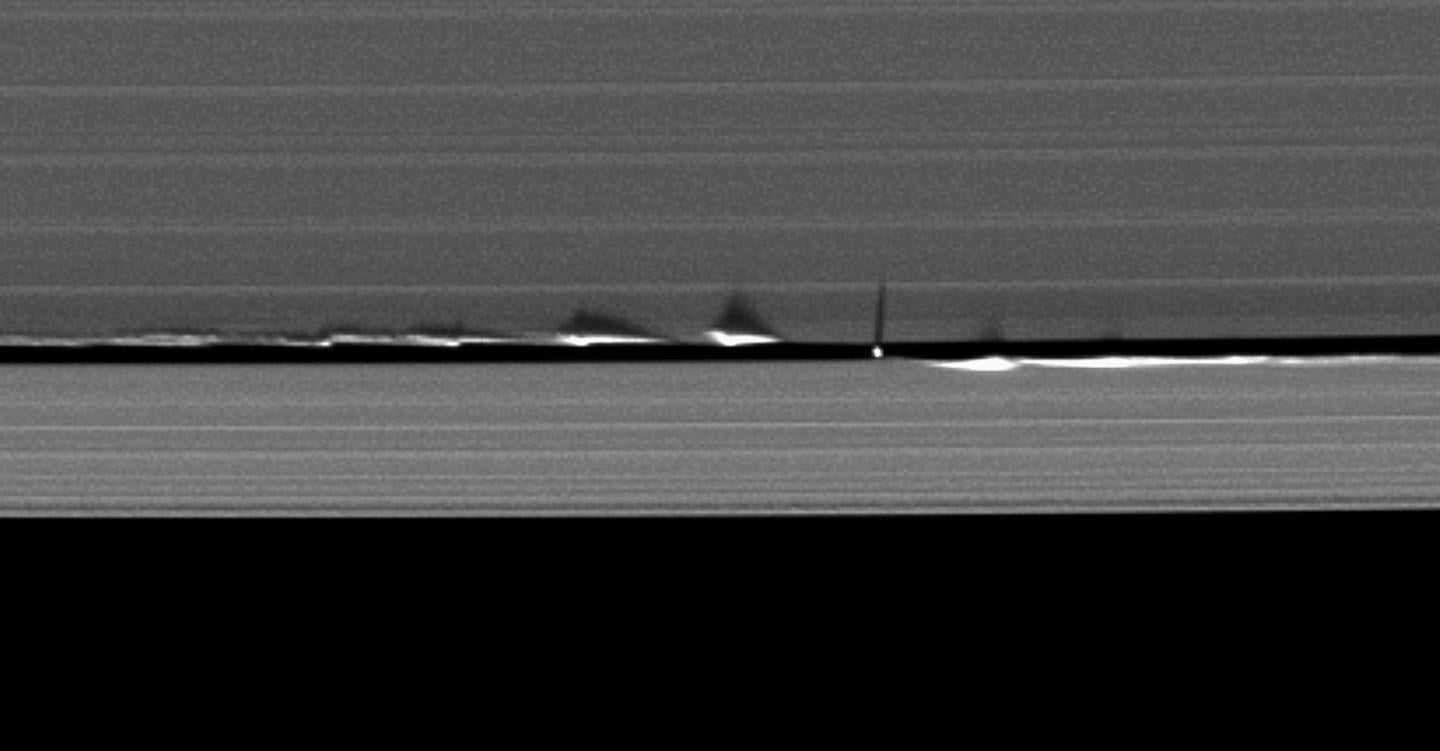
Photo by NASA/JPL/Space Science Institute
Saturn’s rings are amazingly dynamic features. They aren’t solid but are made up of countless chunks of ice, most no bigger than a basketball. Tiny moons orbit among them, carving gaps in the rings with their gravity. In this shot, tiny 8-kilometer-wide Daphnis orbits in the Keeler gap. Its orbit is not centered in the gap but is slightly elliptical and tipped with respect to the rings. Particles closer to Saturn orbit a bit faster, and those outside it orbit more slowly. When Daphnis is above the ring plane, it pulls particles up with it, and when it’s below it pulls them down. Combined with the slightly elliptical orbit, the moon’s gravity creates vertical waves in the ring, ripples above and below the main rings. When this picture was taken, sunlight was falling nearly edge-on to the rings, so any vertical deviations cast long shadows, allowing us to see them. You can even see Daphnis’ shadow stretching across the rings!
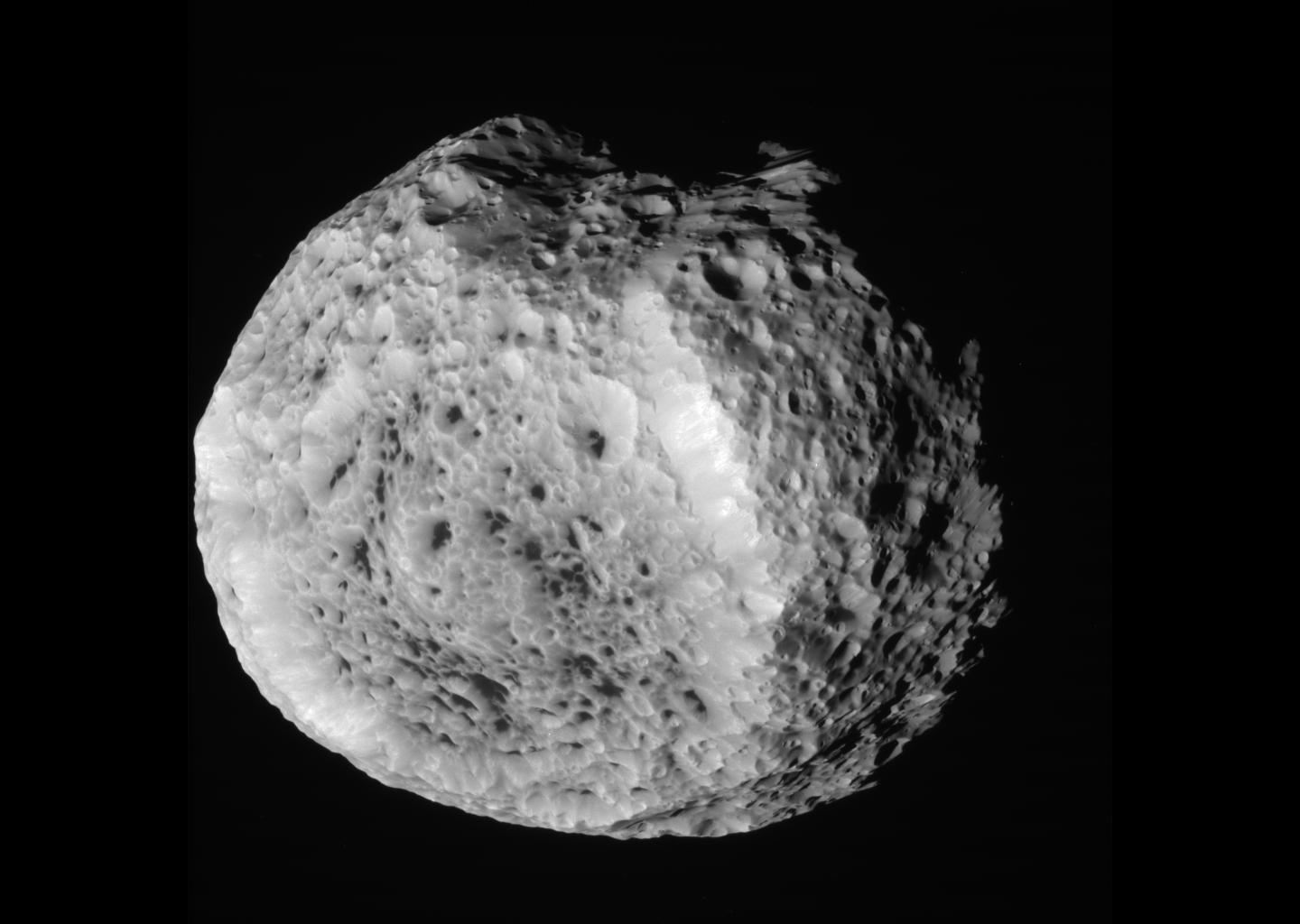
Photo by NASA/JPL/Space Science Institute
Of all the moons orbiting Saturn, Hyperion gets my vote for the most bizarre. It’s saturated with craters, making it look like a Styrofoam ball shot hundreds of times by a kid with a BB gun. It has one huge crater (on the left), and it’s so big that if Hyperion were solid rock, the impact would’ve shattered it. Instead, the moon must have a structure like foam, or a rubble pile, allowing it to absorb the impact. On top of all that, many of the craters have extremely dark material filling their floors. These are made of complex carbon-based molecules zapped and darkened by solar ultraviolet light, which have then flowed to the crater bottoms in Hyperion’s weak gravity.
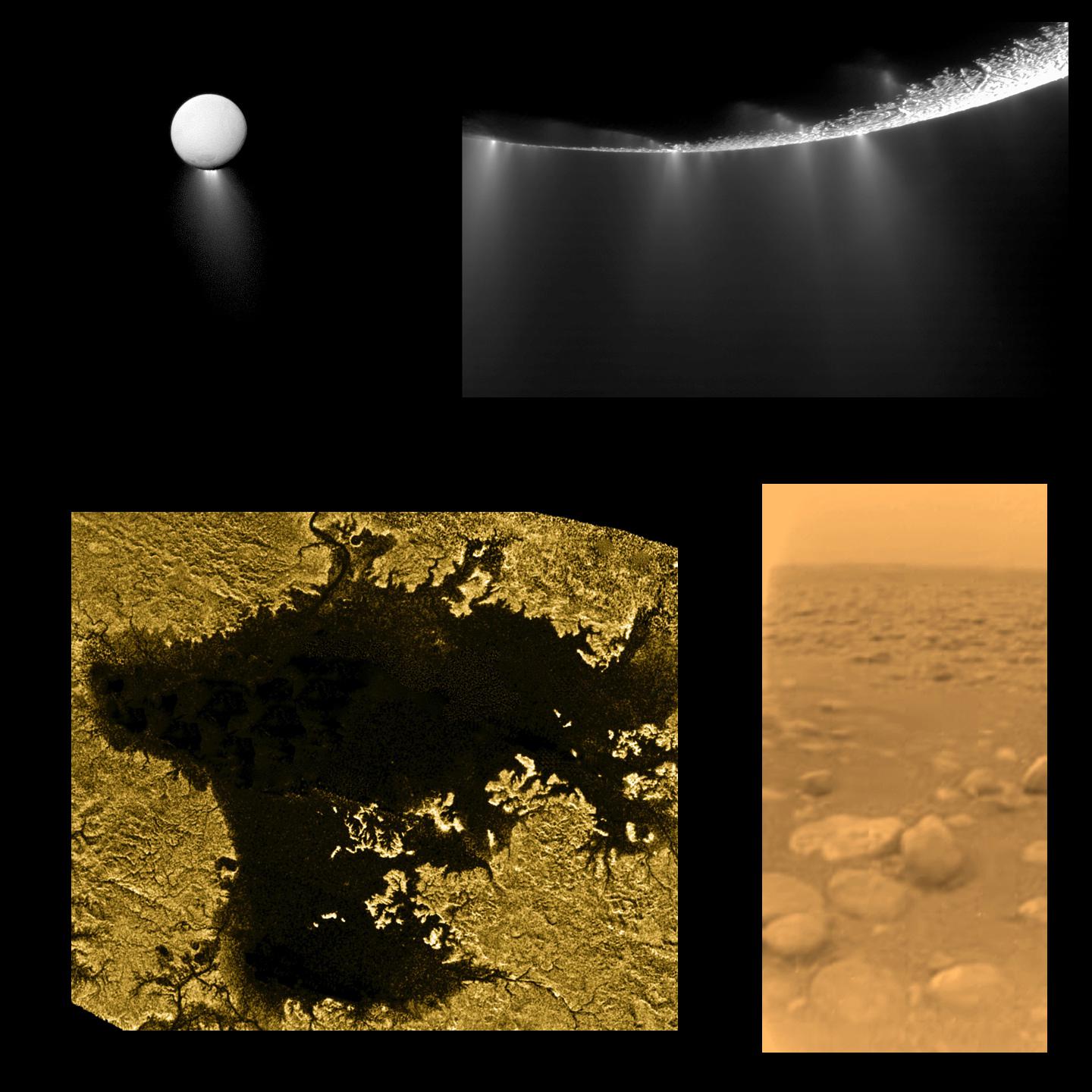
Photo by NASA/JPL/Space Science Institute; NASA/JPL-Caltech/ASI/USGS; NASA/JPL/ESA/University of Arizona
Bonus picture! I couldn’t stop at just 10. One of the biggest discoveries made by Cassini was a series of erupting geysers of water at the south pole of the tiny icy moon Enceladus. From a distance (upper left), the geysers form a plume of ice crystals, much of which escapes from the moon and forms Saturn’s E ring. Up close (upper right), the individual geysers can be seen lit up by the Sun.
Enceladus is not the only liquid moon, though. Huge Titan—nearly as big as Mercury—was discovered to have lakes of liquid methane and ethane. (It’s the only other body in the solar system besides Earth known to have liquid on its surface.) This Cassini radar map of Ligeia Mare (lower left) shows the almost Earth-like tendrils and tributaries of liquid flowing to the lake. Another Cassini triumph was the landing of the Huygens probe on the surface of Titan, the only time a landing has been successfully attempted in the outer solar system. It returned this astonishing picture of the moon’s surface (lower right) showing rocks … made of water ice. The ones in the foreground are just a few centimeters across, and look eroded like river rocks. Although far below the freezing point of water, Titan may have weather similar to Earth, though it is driven by hydrocarbons, not water. Given the complex chemistry on the surface, Titan is another place where scientists think life may have possibly arisen. We can’t know until we send another probe there, which won’t be for quite some time.